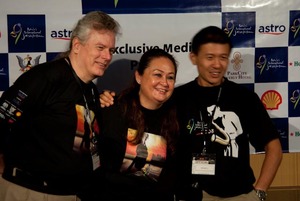Miri, 8 May 2009. At the fourth international jazz festival in oil town Miri, Sarawak, artistes fought jetlag and hangover late morning to respond to journalists’ questions on the role of traditional instruments in their sets, and how they would define jazz. They had flown in from various quarters of the world, to play, what the media (and 6,000 audience) expects to be jazz on 8-9 May 2009.
Except that the selection of bands this year raises a sticky question mark – a few seem to border on world music with gypsy, traditional dance, folk, even Afro pop.Accompanying generic jazz musical instruments were traditional ones. The sort that you would see being played at a Buddhist temple or an Indian classical opera.

Randy Raine-Reusch, Gracie Geikie and Michael Lu plan surprises for all at the 4th Miri Int'l Jazz Fest, even for kids.
But this odd mix was done on purpose, according to the festival’s artistic director Randy Raine-Reusch who also shaped the Rainforest World Music Festival since its inception. “I’m introducing something new and am looking for excellence,” he tells the media, adding that the “balanced programme will be exciting for everybody, from straight-laced jazz to jazz funk, and more.”
Randy was appointed director of the 2009 jazz festival when his illustrious musical background became a little clearer to Sarawak Tourism Board and the organisers of the festival. He had after all dabbled with drum sets, trumpets, sax and possibly a hundred other instruments, studied with the best teachers in many countries, composed numerous scores including jazz pieces, and had recorded with some of the world's greatest crooners.
Jazz, as it appears, is hardly ceramic; instead, it is organic: wet, snaky, even quirky. Taking on forms, textures, colours and beats that arise from cultures, traditions, wisdom, peace, pain, angst, humour and quest for new horizons.
Pascal Seixas who plays double bass in Dites 34, thinks jazz is something of an enigma. “People are looking for new things, and using their music to communicate their lives,” he says. He thinks, however, that people are more open to traditional music than they are to jazz. Perhaps that’s why the band uses the cayamb, a square wooden shaker that originates from the Reunion Islands, along with the accordian, sax, drums and guitar, to express traditional dance music and French folk, along with contemporary jazz.
John Kaizan Neptune of Steps in Time isn’t too sure if his music can be classified as jazz. Having played in jazz and rock bands and the son of a jazz trombone player himself, John says he hears the sounds in his head and creates the texture. “I’m not sure if I call it jazz, but I hope people will enjoy it as much as I create it.”
He is sure of one thing though. “Jazz to jazz is like a language; musicians from other parts of the world may not understand the languages but music composition binds them together,” says John, the man who is world famous for taking a simple five-hole bamboo flute – the shakuhachi – and creating some mean notes from it, backed by a violin, percussion with Indian tabla and ghatam (claypot), and the all too familiar Western drum set. The product: quaint folklore strains at counterpoint with wispy jazz. “I think I can call my music multi-cultural,” he smiles.
South African-born Jeff Maluleke spoke of the origin of jazz as a protest by the blacks against slavery, singing soulfully as they toiled in the fields. ‘It is an expression of pain,” he says. The world touring guitarist, singer and songwriter brings across African themes with western musical instruments.
Jazz?
Maybe, maybe not. World fusion surely. But should we be worried about jazz festivals not sounding like jazz with all its wide-ranging glory from early eras of ragtime, swing, Dixieland, bebop to soul jazz, jazz fusion to free jazz? There’s of course the breakaway from mainstream jazz to subgenres and fusions, to localization. The festival’s a good place to start this discussion, and indeed, the media were rife with this thought even late into the night, and not necessarily finding a conclusion.
The artistes think we should lighten up and stop "putting music into boxes". Maybe we should. We could be a bit more free-ranging too, in our thinking, and our appreciation of musical creations. Expect the unexpected in a Sarawakan festival – World or Jazz - where the element of surprise seems to hang in the air like the magical sunset at Miri.
Bombay Baja Brass Band summed up the discussion by quoting legendary Louis Armstrong who said, “There is two kinds of music, good music and bad music. I play the good kind.”
And oh yes, there were some really good music at the fourth Miri International Jazz Festival, and just one really bad – the Bombay Baja Brass Band (UK) themselves, with the lack of invention and finesse, absence of subtlety and technique, but lots of noise matched by tacky costumes.
Performing great acts at the festival were Alamode (Australia), Dites 34 (France), Double Take (Malaysia), Jeff Maluleke (South Africa), Rumba Calzada (Canada and South America), Thomson Big Band (Singapore), and Steps in Time featuring John Kaizan Neptune (Japan).
There was a tad of jazz in all for sure, and great big chunks of fun.
Photos by Imran Ahmad of Escape Inc.
Read preview of 4th Miri Jazz International Festival by Gaia Discovery here.
Exclusive interview with John Kaizan Neptune on Bamboo magic.
Contact Randy Raine-Reusch of ASZA.